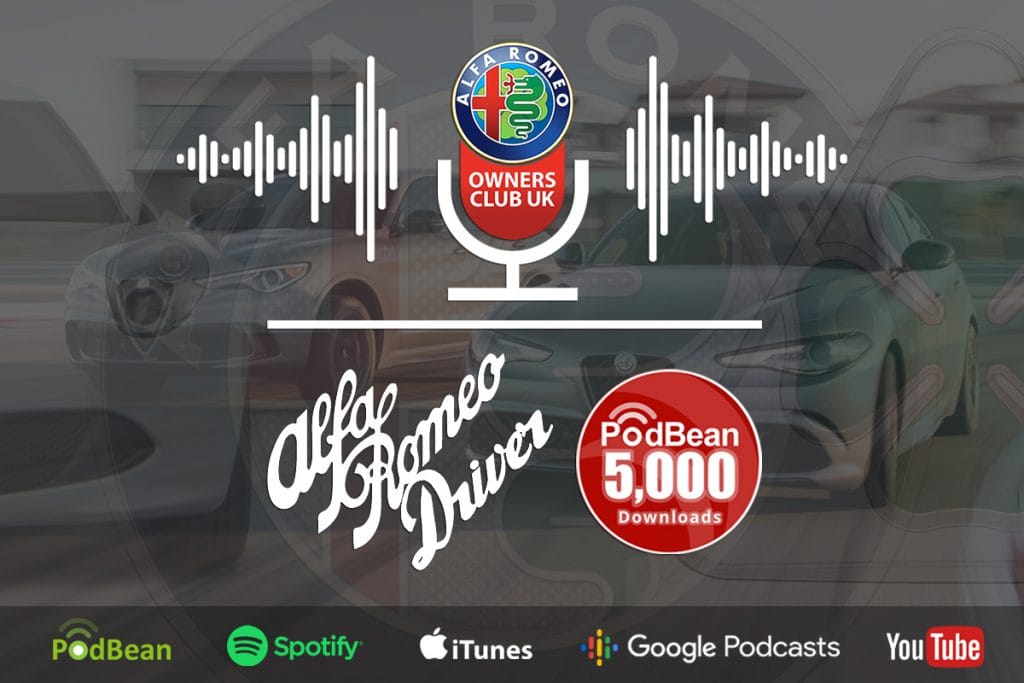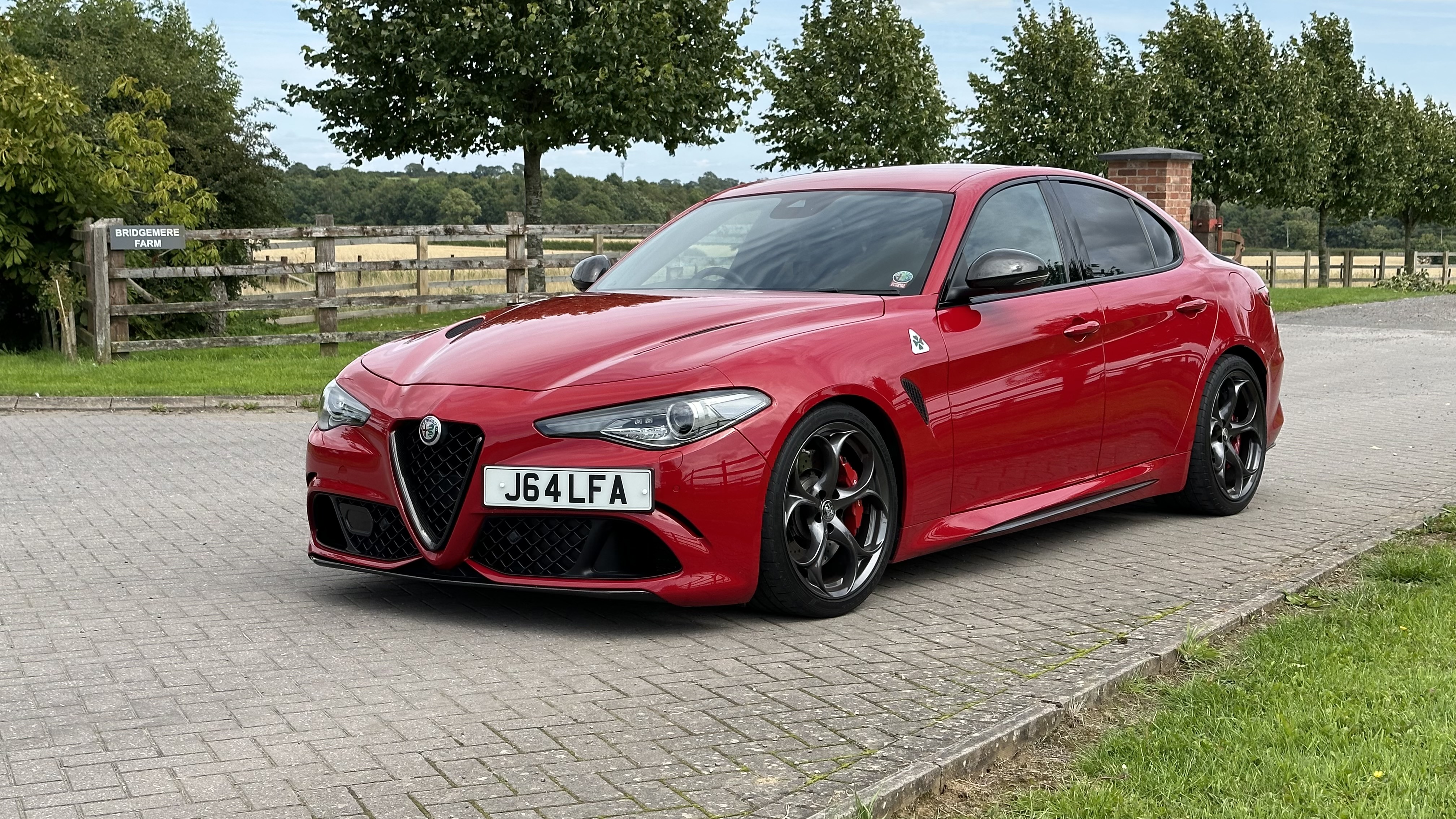
Giulia (Type 952) 2015 - Current
John Griffiths
2891
Alfa Rosso 414
2995

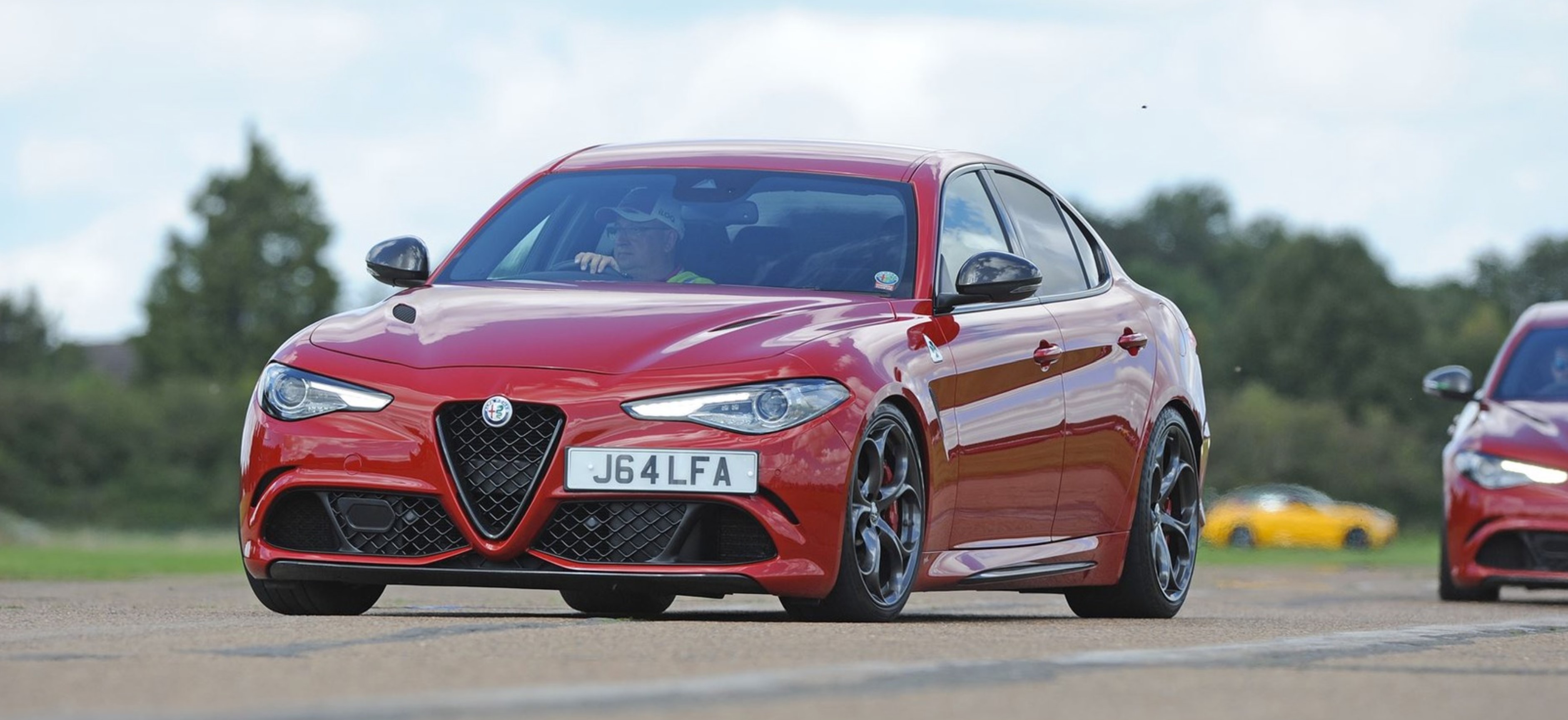
INTRODUCTION

This Alfa is an early example of the Giulia Quadrifoglio (QF) Type 952. It has had a few subtle modifications to further improve the stupendous driving experience that comes as standard.
Boasting the mighty 510hp 2.9 litre V6 Biturbo Ferrari-derived engine, code number 690T, coupled with the 8-speed paddle-shift automatic ZF 8HP75 gearbox, the car features as standard a carbon fibre bonnet, roof, prop-shaft, rear spoiler, front splitter that lowers automatically at high speed and many aluminium panels making it considerably lighter than its competition.
This example has remote controlled exhaust valves, BMC air filters and Eibach Proline progressive-rate lowering springs fitted taking around 30mm from the standard ride height, plus latest Pirelli P-Zero Corsa AR tyres. (Michelin Pilot Sport 4S for winter.)
Manufacturer’s performance figures:
- Acceleration: 0 to 62mph: 3.9 seconds.
- Top speed: 191 mph (307kph)
- Braking: 62mph to stop, 32 metres.
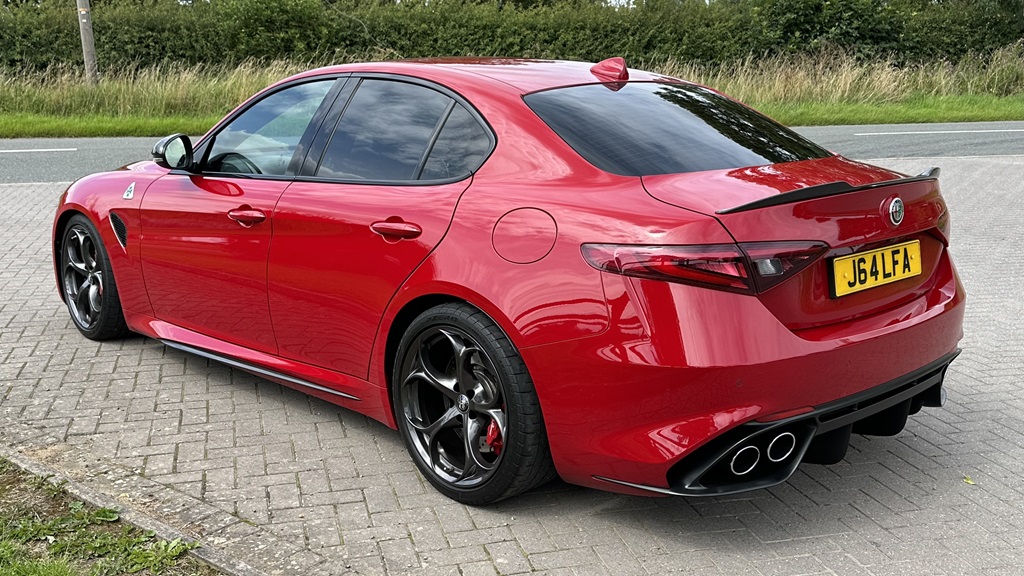
HISTORY

The car was bought new by its first owner at Jordan’s of Hull, and covered just 3,000 miles in its first 4 years. It’s second owner added less than 6,000 miles. It was bought outright by me in May 2023 from a sportscar specialist in Wolverhampton. This Quadrifoglio is my third Giulia after a Speciale and Veloce that were both owned from new. It is in my ideal spec of Alfa Rosso with Alcantara seats and was bought with an incredibly low mileage for its year.
As an early example, it has no petrol particulate filter so sounds absolutely as it should; an incredible concerto of noise from induction and exhaust, and the remote exhaust valve control means you can have the full aural delight in any driving mode, not just ‘Race’! (You can also delight the neighbours by closing the valves sometimes too!) The cold start is a riot of noise when you’re in the mood with more pops and bangs than a Kiss concert when you touch the throttle. In Dynamic mode, the sounds on gear changes are just tremendous, though they can appear under throttle in any driving mode. With the exhaust valves closed the car can cruise quietly and very comfortably too.
The car is the early ‘lightweight’ spec with 4 seat belts and a non-folding rear seat, plus carbon fibre roof which became an 'extra' on later versions.
Alfa Romeo raised the QF’s standard ride height in early 2017 in response to some complaints from people grounding the noses of the first cars. This rather spoilt the car’s ‘stance’, so lowering springs are a visual delight with the downside that you must learn routes around roads with tall speed bumps! The Eibach Proline springs retain the cars brilliant ride and handling and still support the Alfa’s switchable suspension with its comfort mode.
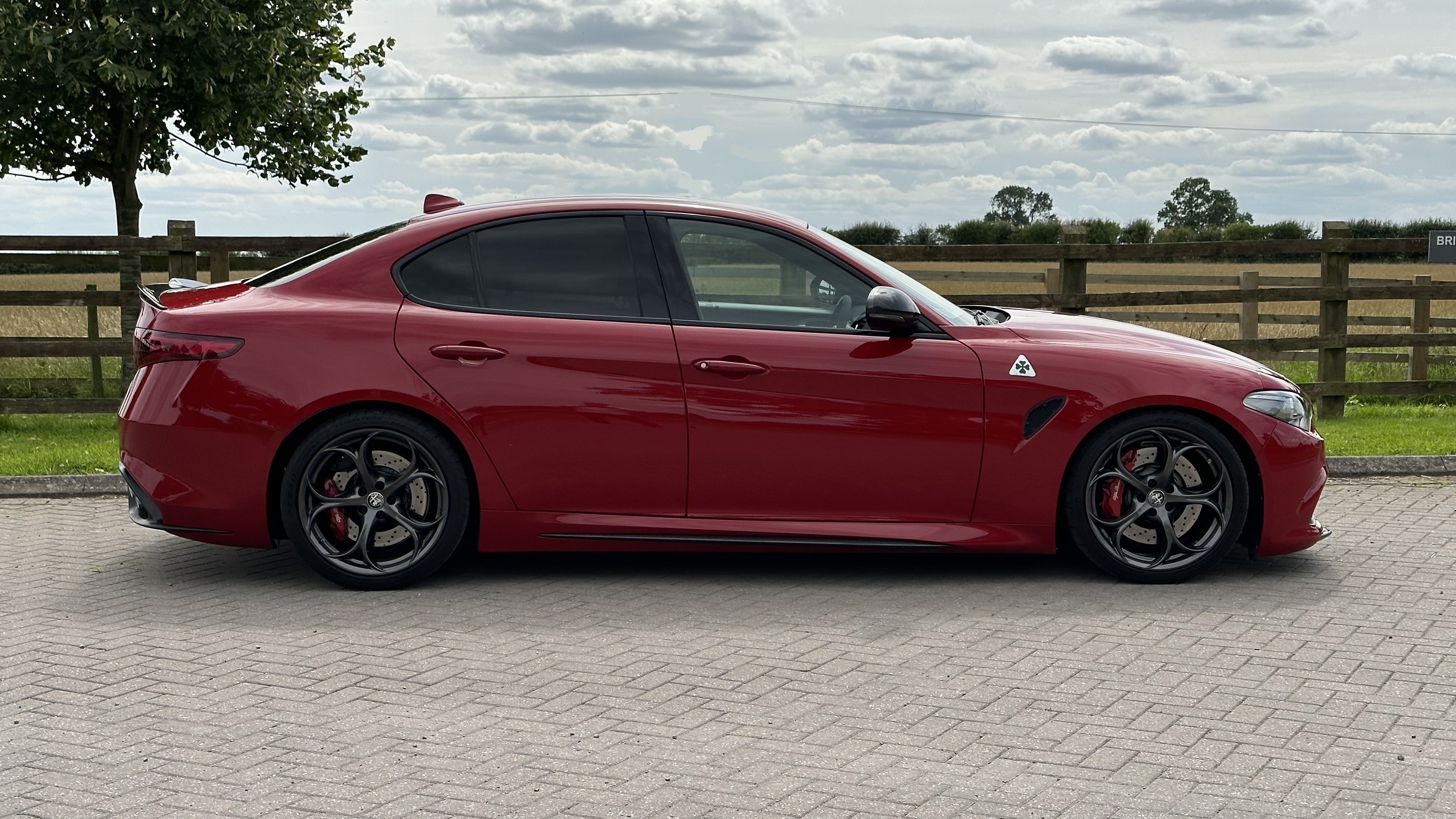
SPECIFICATION

Exterior: Alfa Rosso (non-metallic), 19” Quadrifoglio aluminium wheels in dark grey metallic, red aluminium brake callipers, black window surrounds, covered underbody, rear diffuser, inlayed Quadrifoglio wing badges, 4-way sports exhaust.
Interior: Black leather and Alcantara seats with red stitching and optional electric pack. Red leather inserts to lower dashboard and in door cards, black leather dashboard top. Carbon-fibre trim. Upgraded Alcantara and Carbon Fibre steering wheel. Interior ambient lighting.

FACTORY OPTIONS FITTED

- Harman Kardon Sound Theatre with sub woofer
- Electric seat pack
- Adaptive Cruise Control
- Alcantara and Carbon Fibre heated steering wheel
- Driver convenience pack (inc keyless entry, additional courtesy lights)
- 19” grey metallic five-hole alloy wheels 245/35 8.5J front, 285/30 10J rear.
- Red Brembo aluminium brake callipers
- Cargo net with boot anchor points
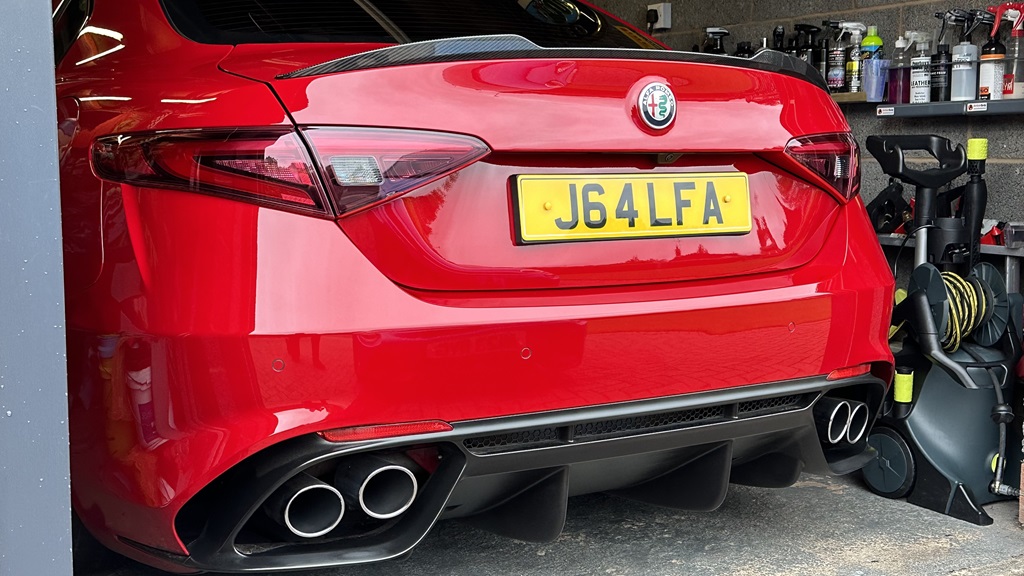
QUADRIFOGLIO STANDARD FEATURES & EQUIPMENT

- Alfa active aero
- Alfa Active Suspension
- Alfa Active Torque Vectoring
- Alfa Chassis Domain Control (CDC)
- Aluminium shift paddles
- Red start button on steering wheel
- Heated seats
- Heated steering wheel
- Leather dashboard top with red stitching
- Bi-xenon 35w adaptive headlights
- LED tail and brake lights
- Power-folding door mirrors
- Rearview camera with gridlines
- U-connect 3d Nav 8.8” Infotainment system
- 7” TFT colour cluster display
- Auto dimming rear view mirror
- Winter Pack
- Cooled glovebox
- Alfa D.N.A. Pro (with Race mode)
- Start/stop – with disable button
- Front and rear parking sensors
- Blind spot monitoring
- Integrated Braking System
- Lane Departure Warning System (can be disabled.)
- Forward collision warning with camera and radar
- Automatic cylinder de-activation in Advanced Efficiency mode.
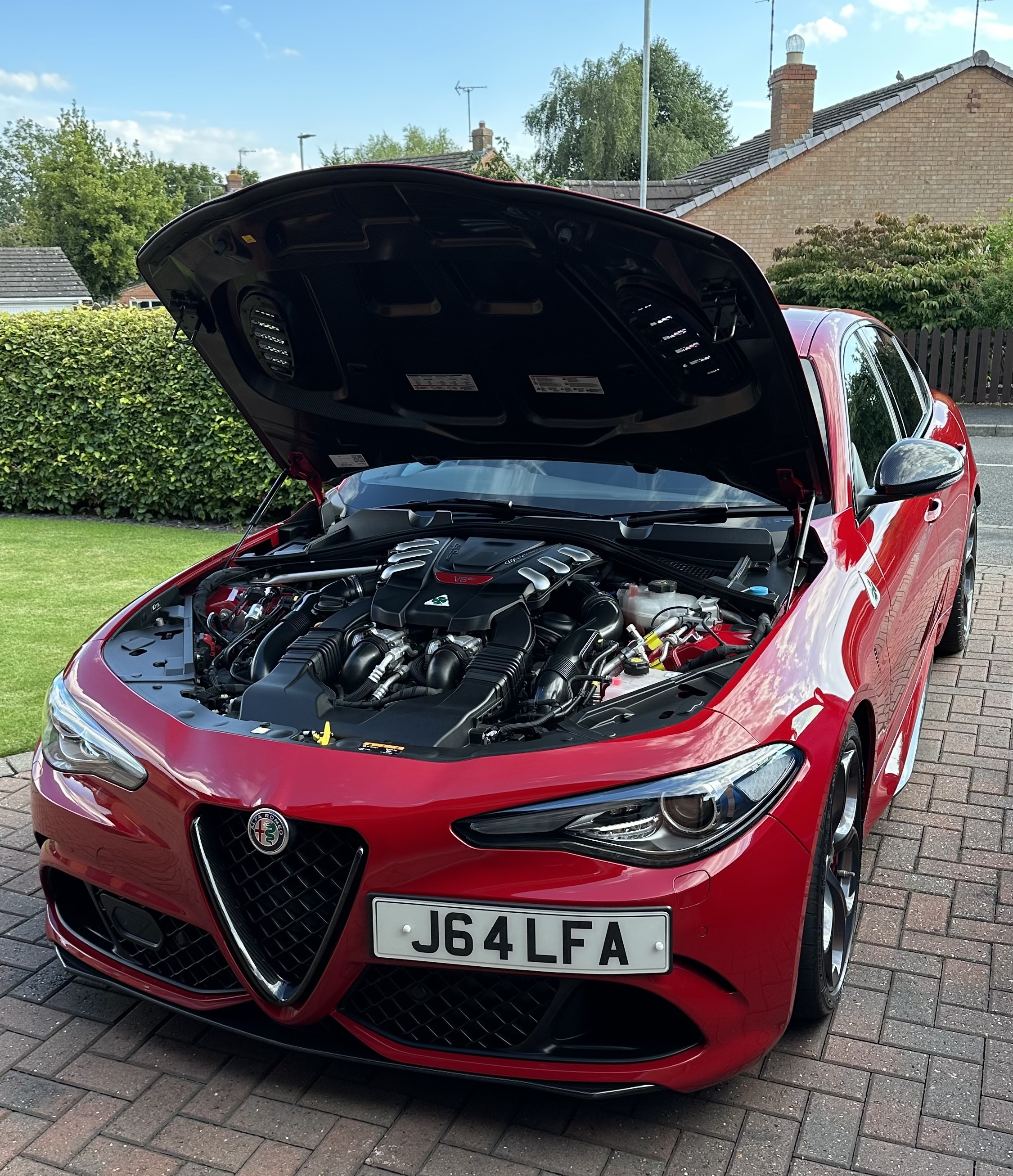
CUSTOM FEATURES

- Privacy Glass (Porsche fitted, removable. Set as per OEM darkness.)
- OEM Alfa Romeo carbon fibre mirror caps
- Carbon fibre Scudetto grille
- BMC sports air filters
- Eibach Proline progressive rate lowering springs
- AHM remote exhaust valve controller
- Full geometry set up by String Theory Garage
- OEM Pirelli Corsa AR tyres fitted 2024. Michelin Pilot Sport 4S tyres stored for winter use.
- Ceramic paint and trim coatings applied

HISTORY OF THE TYPE 952 ALFA ROMEO GIULIA QUADRIFOGLIO

In 2013, Fiat Chrysler Automobiles CEO Sergio Marchionne requested a clean-sheet design for the next Alfa Romeo—a rear-wheel drive sports saloon to help return the company to its roots. He appointed former technical director at Ferrari and chassis engineer for the 458 Speciale Philippe Krief as chief engineer for the Giulia and asked him to assemble a team of ten to create the Giulia, to be designed and built in two and a half years. Krief oversaw the development of the Giulia, along with the platform that underpins it—Giorgio. This was an all-new, longitudinal-engine, rear-wheel drive platform developed by Alfa Romeo.
The top-of-the-line Giulia Quadrifoglio (Italian for "four-leaf clover") was the first model in the new Giulia range. It was unveiled in Italy in June 2015 and made its official international debut at the 2015 Frankfurt Motor Show. Cars did not arrive in the UK until late 2016.
The Quadrifoglio is powered by an all-aluminium alloy, twin-turbocharged gasoline direct injection 90° V6 engine, with a single-cylinder displacement of just under half a litre, for a total of 2,891 cc (176.4 cu in; 2.9 L). This engine was developed for the Quadrifoglio by engineers with Ferrari background and is derived from Ferrari's own twin-turbocharged F154 CB V8 engine, sharing the Ferrari California T's bore & stroke of 86.5 mm × 82 mm. The engine has a maximum power output of 510 PS at 6,500 rpm, and 600 Nm (443 lb⋅ft) of torque between 2,500 and 5,000 rpm. The turbochargers are single-scroll compressor IHI units integrated into the manifold, with water-charge air coolers. It has side-mounted direct fuel injection and peak turbo boost reaches up to 35 psi (2.4 bar) absolute pressure. With the inclusion of cylinder deactivation (that can switch off a bank of three cylinders) the QF can achieve some remarkable economy relative to its stupendous performance; over 35mpg can be achieved on gentle motorway running.
From the front, the Quadrifoglio distinguishes itself from the rest of the Giulia range by a specific front bumper with a carbon fibre splitter and enlarged air intakes for the twin intercoolers and for the brakes and by a carbon fibre bonnet featuring two cooling outlets for the engine bay. On the sides, the front wings also have outlets to extract air from the wheel wells, and bear Quadrifoglio badges in its model-specific front wings; the side skirts are specific to the model too with carbon fibre spoiler inserts, as are the 19-inch alloy wheels. At the rear, a low-profile carbon fibre lip-spoiler is applied to the boot lid, and a huge rear diffuser makes up the lower half of the bumper flanked by quadruple exhaust tips. Working in conjunction with the faired-in underside, the diffuser is fully functional in generating downforce also incorporating turning vanes, and at the front is the "Active Aero Splitter", which can vary its angle of attack by 10°, moved by electric motors automatically at speed. These were firsts in the Giulia's market segment and able to generate significant downforce. The Giulia Quadrifoglio has a drag coefficient of Cd=0.32, remarkable given the 10-inch wide rear wheels, though up from the normal car’s 0.26. Mechanically, this QF is fitted with a torque-vectoring rear differential able to send 100% of the torque to the left or right wheel in an instant.
On the interior, the dashboard is part-trimmed in leather and carbon fibre and the red engine start button is located on the multi-function steering wheel. There are long solid aluminium shift paddles attached to the steering column. In addition, the driver is offered Alfa Romeo's "DNA" dynamic control selector, which is placed on the centre console. Driving modes include "Dynamic", "Natural" and "Advanced Efficiency" modes (the last one uses cylinder deactivation for increased fuel economy), and "Race" for high performance with louder exhaust note and electronic stability control systems turned off.
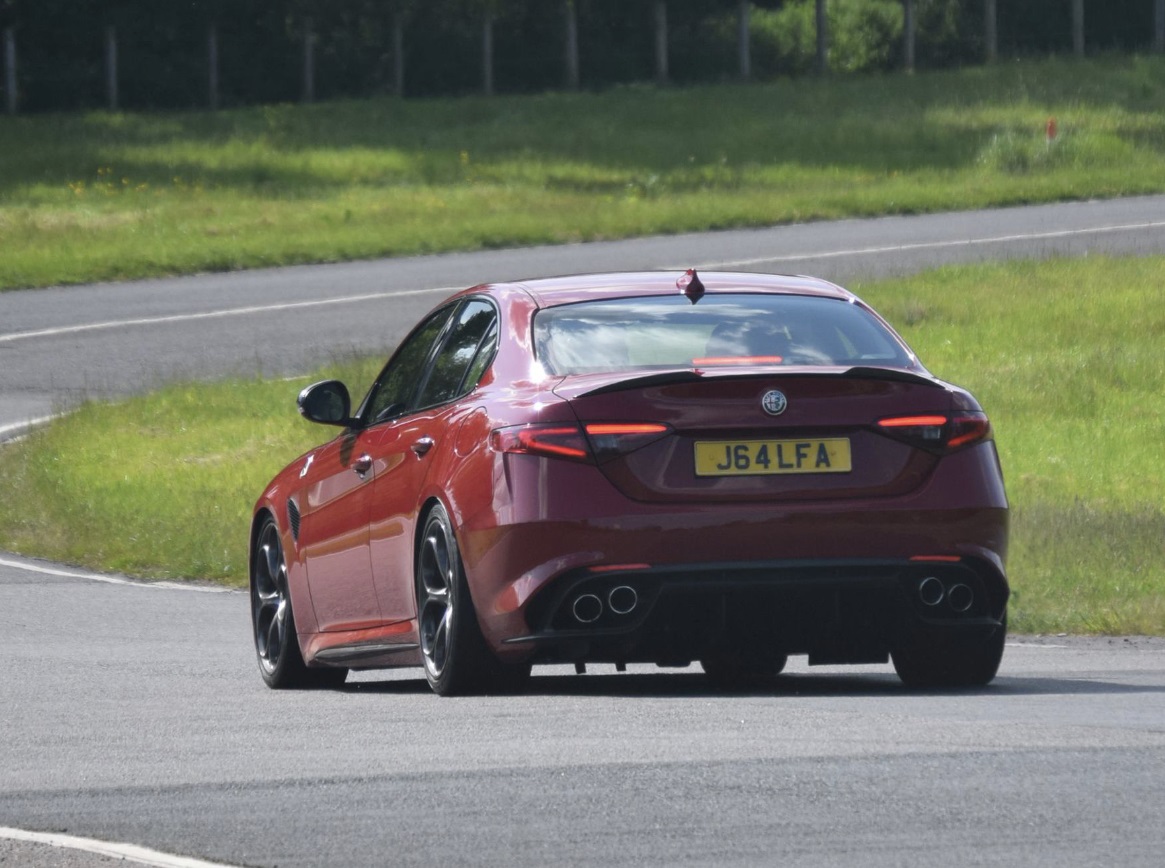
PERFORMANCE

According to Alfa Romeo, the Giulia Quadrifoglio can accelerate from 0 to 100 km/h (62 mph) in a blistering 3.9 seconds and come to a standstill from that speed in just 32 meters. The Quadrifoglio can attain a top speed of 307 km/h (191 mph).
This model completed the Nürburgring's Nordschleife circuit in September 2016 setting a new lap record for a saloon car with automatic transmission: 7 minutes, 32 seconds.
Car and Driver magazine recorded a standing quarter mile time of 11.9 seconds at 195 km/h (121 mph) and a 0 to 97 km/h (60 mph) acceleration time of just 3.6 seconds. The car also lapped the Top Gear test track in 1:21.40, faster than several supercars and substantially faster than the BMW M3 and C63S.
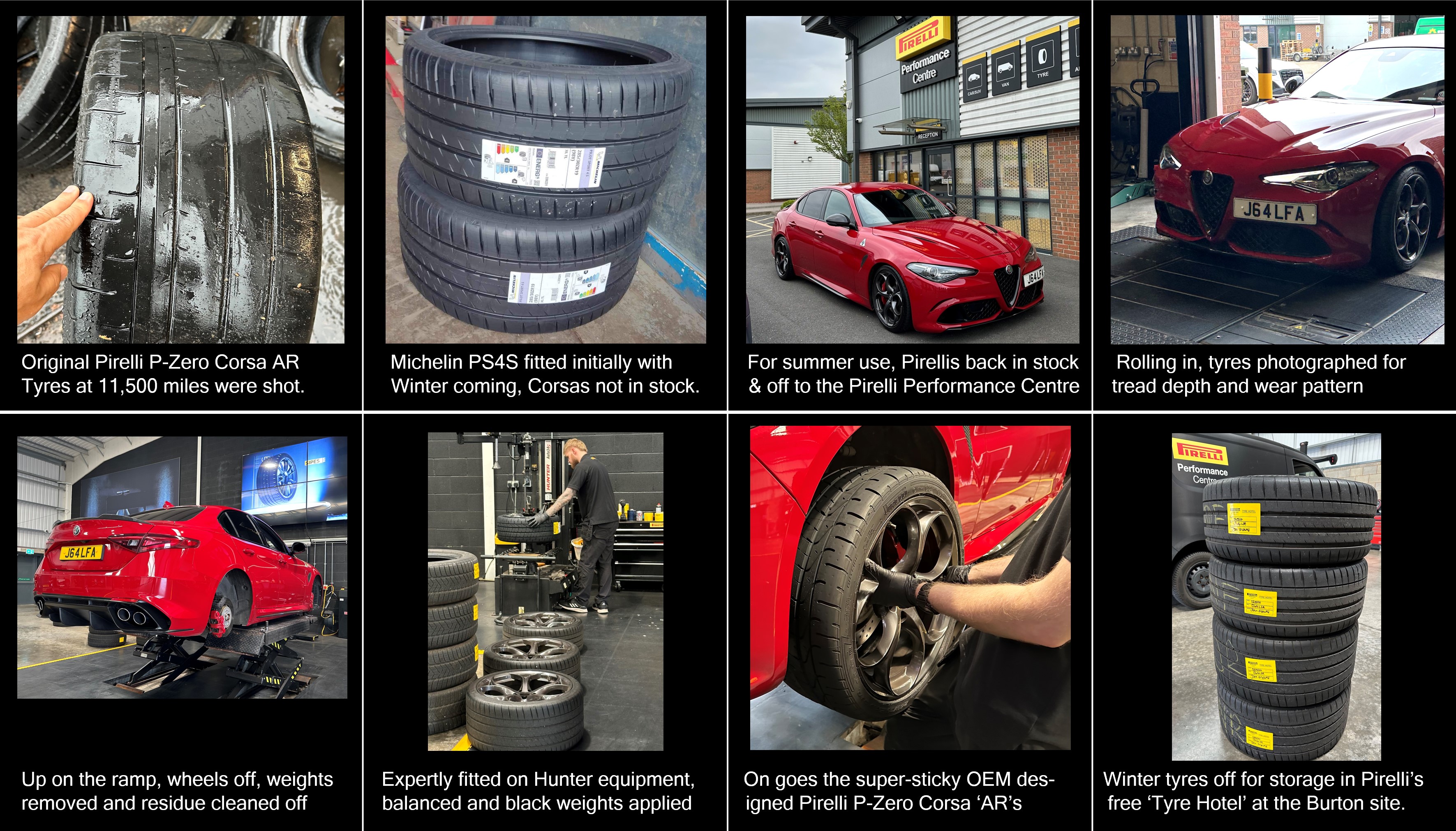
TYRES

The Quadrifoglio’s original factory-fitted Pirelli P-Zero Corsa AR tyres were not in the best of state when bought by me, though still with around 3 mm of tread, just under half the original 6.5mm depth. That’s remarkable given the car had nearly 9,000 miles on the clock given they are super-soft high-performance tyres. Good evidence of some gentle past ownership anyway. They worked great over the summer on warm roads giving simply phenomenal grip. They did give a lot of drag/tramp in low speed manoeuvring, exacerbated by the Ackermann effect that gives the Giulia a wonderfully small turning circle. Road noise was high too as there was so little tread depth left by the end. Gradually, rain induced some severe buttock-clenching moments on traffic islands, not enjoyable at all and they had to go.
After a week of tippy-toeing around wet traffic islands, and with the Alfa Romeo OEM Corsas out of stock (there’d been a lot bought on summer), and the new PZ4 unavailable in 285/30/19, I ordered some Michelin Pilot Sport 4Ss. That’s a relatively old tyre but the one I’d heard many good things about. These worked very well over the extremely wet winter.
For Summer 2024, I fitted the latest P-Zero Corsa ARs at the brilliant Pirelli Performance Centre in Burton-upon-Trent. The barely-worn Michelin tyres on the car put into their ‘tyre hotel’ for future bad weather use. (That’s a free service for AROC members buying a set of new tyres there.)
The team at the PPC replaced all the wheel weights with black ones that looked loads better, also grinding off the wheel weight residue.
The latest Corsa AR tyres feel superb, no noisier than the PS4Ss and with simply stupendous grip, that’s surprisingly good in the wet. They are an extreme performance tyre, but they make the car exactly as designed by the car’s development team.
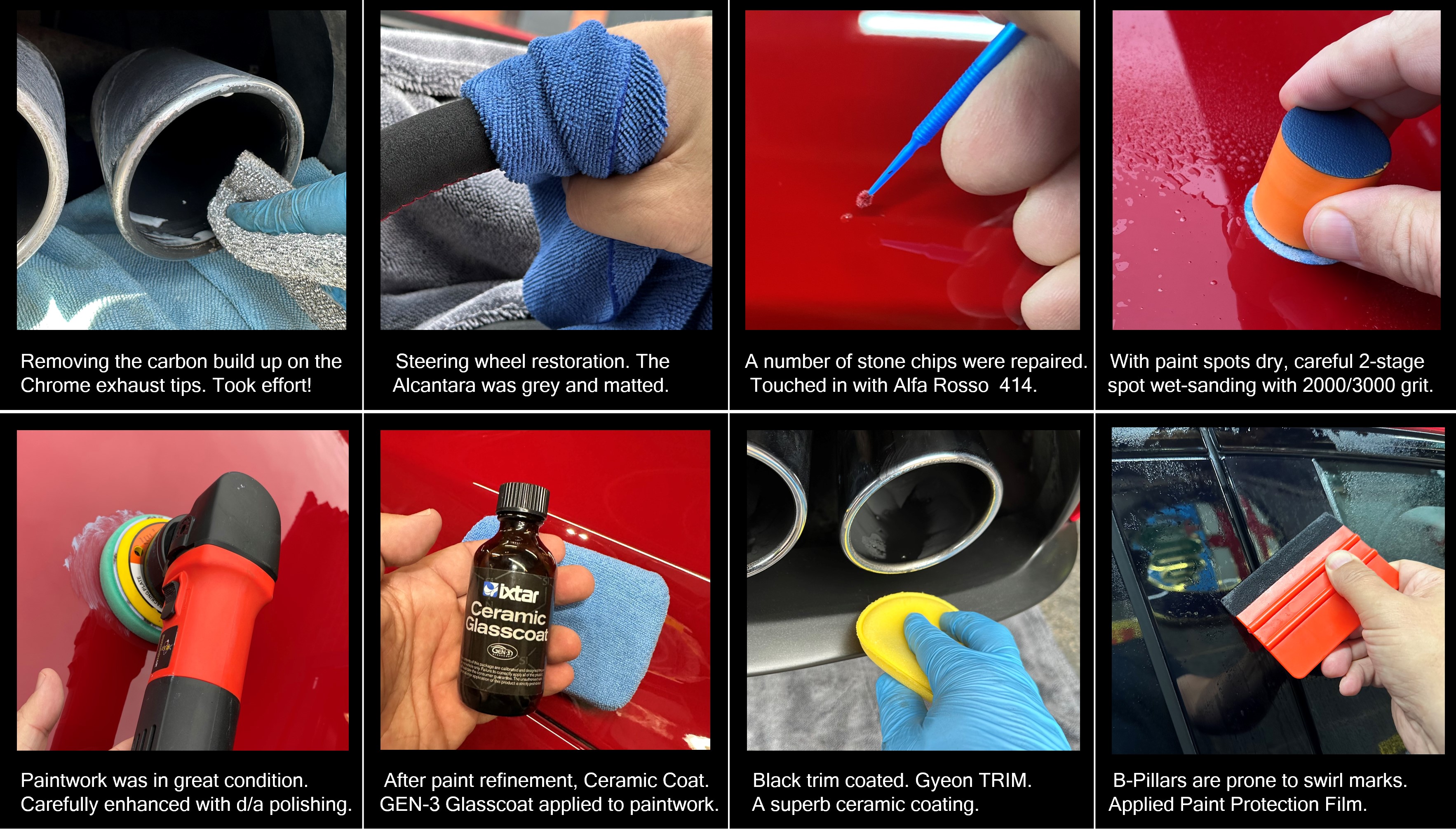
DETAILING

I'm a Certified Detailer, though not a professional. Well, my wife thinks I should be certified for sure - but I did receive an official Detailing accreditation in 2021. Buying a used Giulia after two brand new ones has made for hours of entertainment in bringing it back to ‘as new’ as I can get it.
First off was interior, which was pretty much ‘mint’, but the steering wheel needed urgent attention as it had never been cleaned, with horrifically matted Alcantara inserts. These were thoroughly dry brushed before various foam cleaners applied, leather cleaner and brushing too. Result, as new!
The solid Rosso paintwork had been corrected by the specialist I bought it from and looked swirl free, but there were about 20 or so small paint chips on the nose and bonnet, a couple on A-pillars and roof. I used the spot painting technique followed by light wet sanding and spot polishing. I then performed a refinement polish with a dual action polisher, mainly using Rupes Uno Pure compound which really jewelled the paint. I then applied a professional Ceramic coating; Gen-3 Glasscoat, which is straightforward to apply and level.
Other areas dealt with: the A-Pillars were coated in 3M Paint Protection Film (PPF). The black trim initially coated in Turtle Wax Graphene Acrylic trim coat, but later replaed by Gyeon Trim ceramic coating which gives a more factory finish. The chrome exhaust pipe tips were plastered in carbon build up and needed a lot of work to restore ultimately using the finest wire wool, Scotch pads and various chrome and metal polishes. Under the bonnet, I replaced the tatty fabric Loom Tape with fresh flame-retardant type. Under bonnet plastics were treated with CarPro PERL at 1:3. The wheels were in good order bar a few spots that had embedded iron particles. These were removed with multiple doses of Iron fallout remover and brush agitation. Wheels and callipers were Ceramic coated.
Now it’s down to maintenance with careful washing. I always pre-wash with Bilt Hamber Touch-less snow foam, but use a variety of shampoos including on occasion Koch Chemie Rs (Reactivation Shampoo) clear off older QD coatings and mineral deposits from rain water. I use a variety of QDs and Rinse coatings (including Bilt Hamber Touch-on and Gyeon Wet Coat) to add some bling too naturally.
Being a Detailing nut the QF is always a test bed for new products of course!

THE DIFFERENCE OVER A GIULIA VELOCE

The 2-litre 280hp Giulia Veloce is a sensational car and a quite brilliant all-rounder. You can tell it was developed from the Giulia Quadrifoglio rather than the other way around, so it still boasts sensational steering, cornering and exotic features like a carbon fibre prop-shaft, though not the QF's carbon fibre roof and bonnet. However – the Quadrifoglio has an extra 230 horsepower and a lot more torque so the level of performance goes from highly impressive for a saloon car to utterly astronomical!
Accelerate in a Quadrifoglio, in any gear, and it charges for the horizon. Overtaking is sensational, and incredibly safe, and you have to be very careful with speed limits! The force of acceleration on full throttle presses you into the seat. Happily the big brakes are hugely impressive too. And the sound: there’s just nothing like it. Dominated by exhaust when valves are open, the BMC airfilters liberate a little more induction noise under load. It’s a gigantic amount of fun blipping through the gears and hearing the crackle and snarl from the V6. Happily for such a sports machine, it is extremely comfortable. The electric seats have electrically adjustable side bolsters and lumbar support so you can sit just right, and the suspension is a marvel. The bumpy road button activated in Dynamic and Race modes really useful in the UK.
And its looks. No saloon car on the road has a rear like it. That diffuser and the huge under body aero fins. The deep front spoiler with its extending carbon fibre lip. The curvaceous carbon fibre bonnet with air vents, that nose-down stance with the vast rear tyres. The inlayed Quadrifoglio badges on its flanks. The broad sills with their carbon fibre inlays, that sharp carbon lip tail spoiler - just so many delightful details to enjoy looking at. And it has such terric presence on the road.
Any criticism? With its massive level of performance it’s hard to indulge only for brief instants, but that’s largely true of the Veloce too. When you can though – well, there’s very little like it this side of a Ferrari, remembering it has more power than a V12 Lamborghini Diablo!
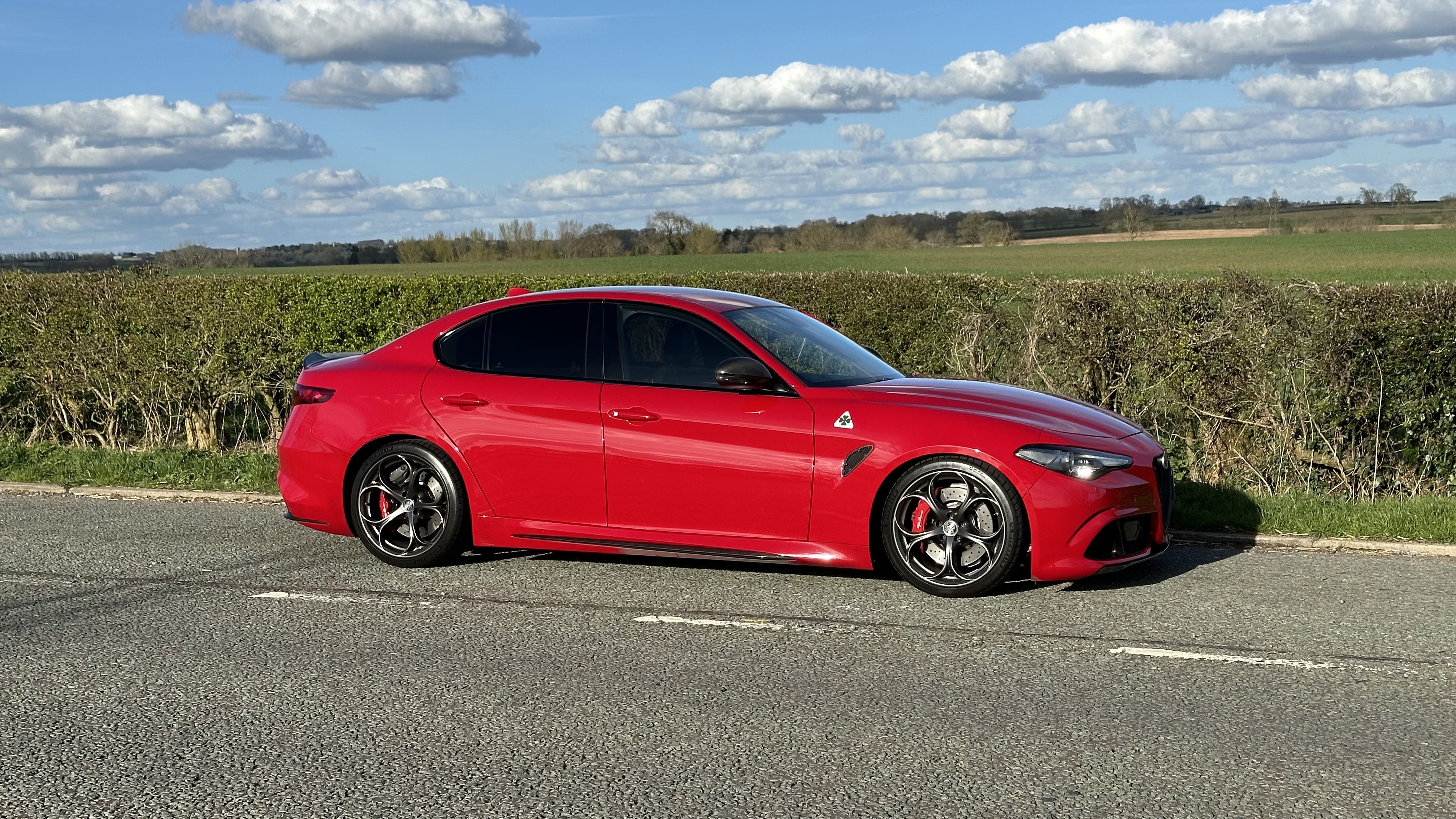
SUMMARY

For some time Alfa Romeo’s fastest-ever production car, the Giulia Quadrifoglio has a significant problem. The world isn’t big enough - it’s WAY too fast!
Happily, even when using a fraction of its capabilities to complete a journey, it is absolutely thrilling, a complete joy. Want to have a relaxing run? Pop it into Advanced Efficiency mode, close the exhaust valves and cruise in comfort. Under 77mph the cylinder deactivation switches in and you're effectively running a 1.5L 3cyl single turbo and you can see 40mpg. (Personal best over 100 miles, 37mpg. All 6 cyliders will reactivate as required, for example to heat the catalytic convertor for efficiency, and it's unnoticeable in either direction.)
Want to take it on track, as I have briefly at Curborough sprint circuit and on the AROC National Alfa Day parade? Select Dynamic or Race mode, suspension firmed up, valves open, and you can have an absolute ball.
I’ve owned Alfa Romeos of many types since the 1980’s and enjoyed them all – this one though is just so very, very, special. A car you genuinely fall head over heels in love with. The team got it so right. A full 5 stars.




